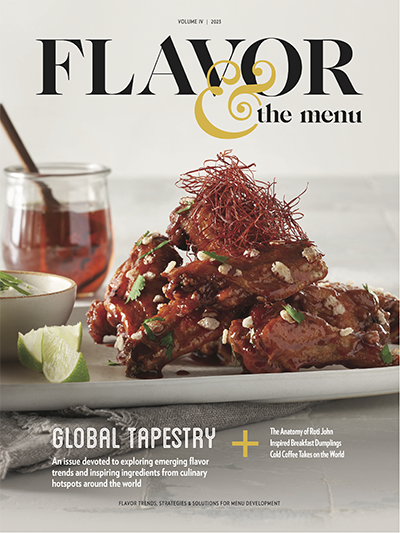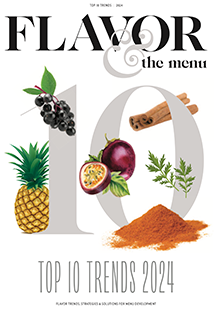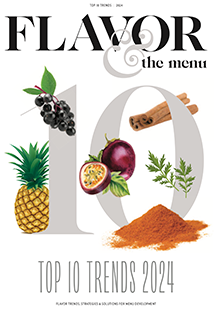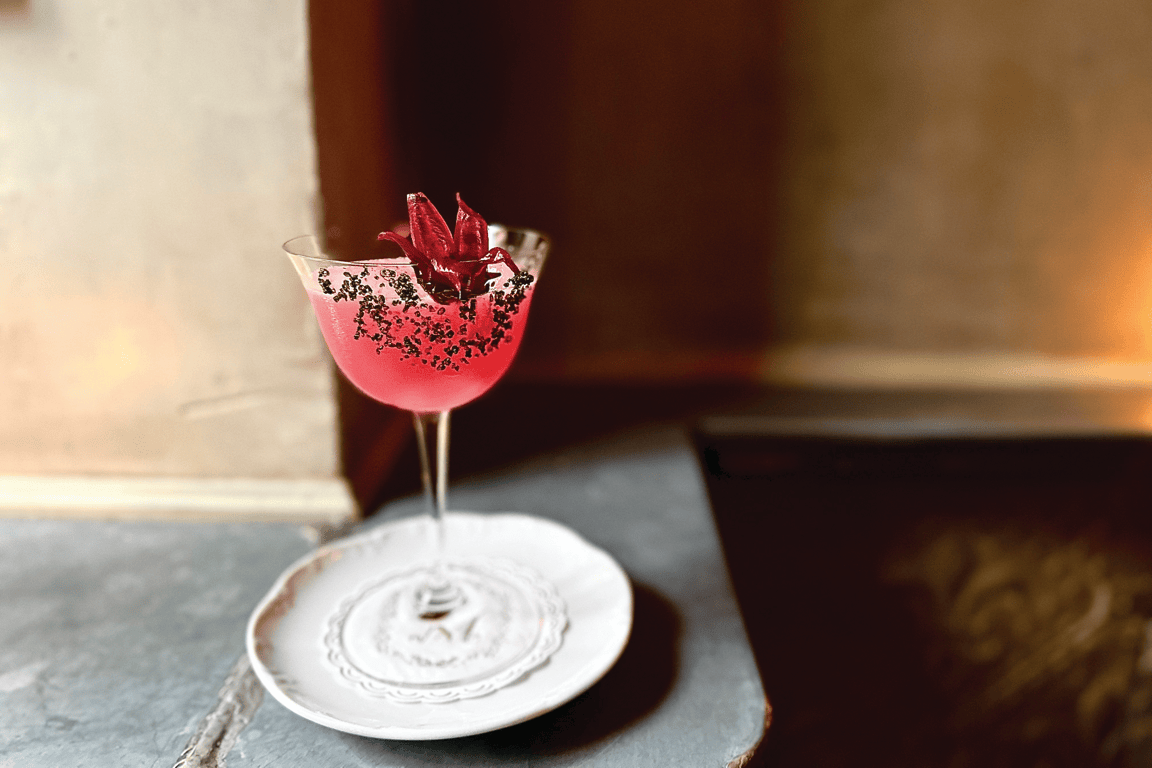
Mexican Beverage Boom
A deeper exploration yields a world of surprising opportunity
Mexican Beverage Boom
A deeper exploration yields a world of surprising opportunity
By Katie Ayoub
February 7, 2024
By Katie Ayoub
February 7, 2024
If ever there was a safe bet in modern beverage development, Mexican-inspired builds is it. American consumers provide a ready fan base, generating a fever pitch for classics like the margarita and agua fresca; rallying behind newer discoveries like mangonada, horchata and the michelada; and cheering on the adaptation of lesser-known drinks and ingredients like ponche, carajillo, sotol, palo santo and hoja santa. Today’s trend digs into all of the above, along with many more flavors direct from Mexico. To underscore the opportunity, look to the purchasing patterns of today’s consumer: The margarita is the most ordered cocktail in the U.S., and Modelo Especial now ranks as this country’s best-selling beer, according to Nielsen tracking.
“If you’re looking for a new winning beverage option, your first go-to in ideation should be around Mexican flavors. There’s overwhelming evidence that these flavors are hugely popular,” says Mike Kostyo, VP of Menu Matters consultancy. “So, now the question is: ‘How do you move it to the next level?’” Savvy developers are taking a few different approaches to next-level Mexican-inspired beverage building. They’re refreshing classic drink lineups with impactful flavor touches from the Mexican pantry, pulling in lesser-known liqueurs, fruit infusions, chile pepper accents, exotic plant syrups and garnishes, and even a few savory surprises. They’re also introducing customers to entirely new flavor combinations while giving spin to boozy and non-alc favorites with deep-rooted popularity in Mexico, from carajillo and café de olla to champurrado (a chocolate grain-based drink) and licuado (smoothie).
“There’s so much more to offer within Mexican cuisine,” says John Baez, executive chef, Border Grill in Las Vegas. “We’ve been able to dig deeper into the heart of Mexico—Oaxaca, Ensenada, Veracruz and beyond—and find all these culinary traditions and delights. That’s what’s exciting—that we’re able to be a part of this movement.”
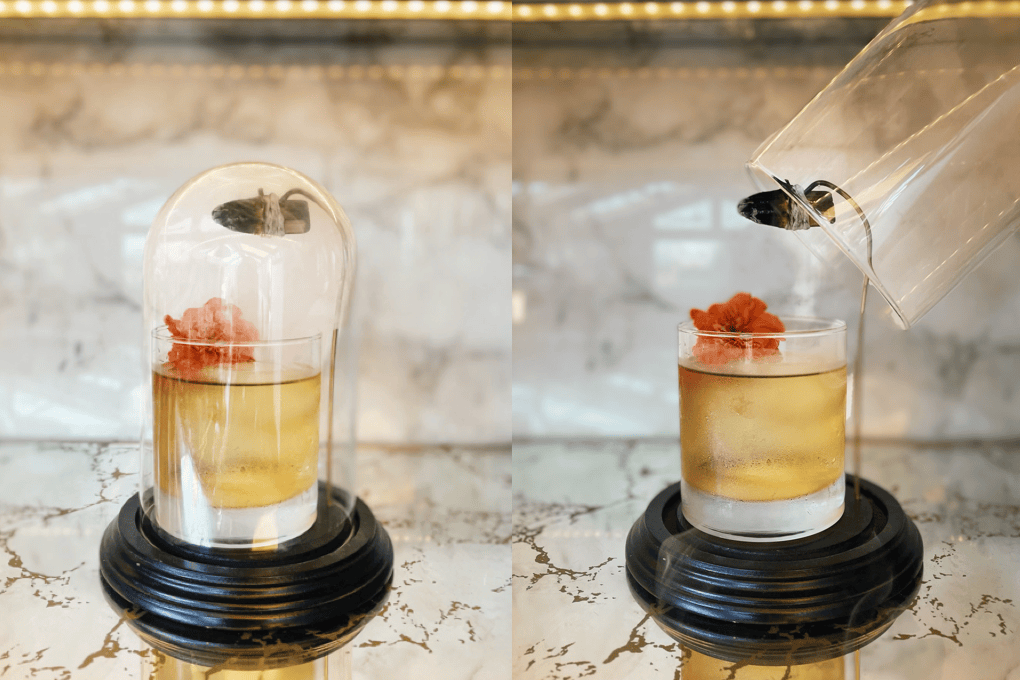
At Michael’s on Naples in Long Beach, Calif., torched palo santo lends the mezcal-forward Dea Divina cocktail both drama and aromatic depth.
Building on Favorites
The most straightforward play sees beverage developers applying Mexican influences to cocktail classics. It’s a sound strategy. “If you already have a beverage that’s doing well on the menu, add an iteration that features Mexican flavors and ingredients,” says Kostyo. At Ghost Commerce in Commerce Charter Township, Mich., an Old Fashioned morphs into the Añejo Old Fashioned, featuring El Mayor Añejo, orange bitters and agave. Across the country, at Paradisaea in La Jolla, Calif., the Oaxacan Negroni surprises with Tamarindo Mezcal, rosé vermouth, ancestral Mexican corn liqueur and Artigianale bitters. Sal de gusano (worm salt) is sprinkled over top to finish the drink.
Riding the popularity of the espresso martini, and demonstrating the appeal of Mexico’s own classics, the carajillo is making moves on American menus, with beverage developers offering riffs on the traditional combination of strong coffee and Licor 43, a Spanish liqueur with notes of warm spices, citrus and vanilla. At Suerte in Austin, Texas, the Carajito is carajillo-inspired, with rum, Licor 43, Fernet-Branca, cold brew and spiced cocoa bitters.
Indeed, the carajillo is an example of an easy layup for American beverage development, says Baez. “It’s the next evolution of the espresso martini and will gain a following because it’s in the comfort zone of Mexican flavors. Ponche has similar potential,” he says. Mexican ponche is a style of warm punch, typically made with apple, pear, orange and guava, then spiced with cinnamon, cloves, tamarind and hibiscus. Variations abound, including chilled and boozy versions. At Washington, D.C.’s dLeña Roja, the Piña Punch is made with coconut fat-washed mezcal, ginger-mint syrup, lime and pineapple soda. Simone’s Bar in Chicago menus Ponche de Pilsen, an iced punch with mezcal, Bitter Truth dram and housemade Christmas punch flavored with fruit, hibiscus and spices.
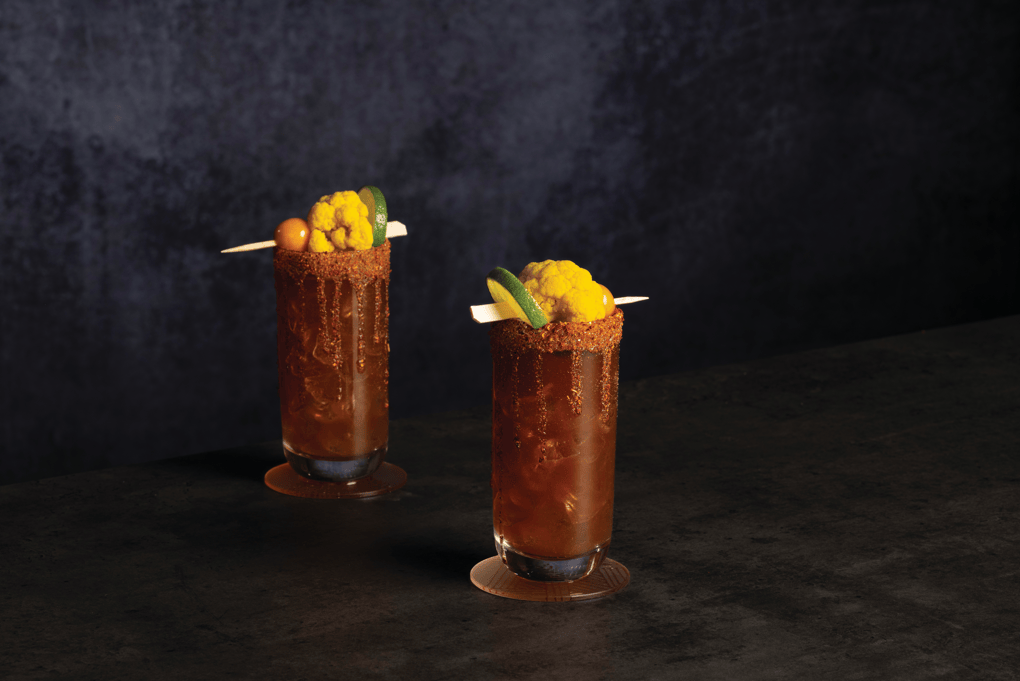 Photo Credit: Kikkoman Sales USA
Photo Credit: Kikkoman Sales USA The Michelada at Jūn in Houston is an umami-rich spin on this classic, featuring Modelo, fish sauce, hoisin, chile and lime, with an eye-catching cauliflower garnish.
On the Horizon
Mexico’s culinary landscape, rich with diverse flavors, provides fertile ground for imaginative menu development. “There’s so much out there that we can leverage to make popular, great-tasting drinks,” says Baez. “We think about mole rims and infusions of tepache or agua fresca as mixers, and we like to highlight Mexican versions of traditional spirits, like sotol and Mexican corn whiskey.” Kostyo agrees: “We’ve seen mezcal grow on menus over the last five years. But if you want to be ahead of the curve, look to those next-generation, interesting, distilled spirits coming out of Mexico, like sotol.”
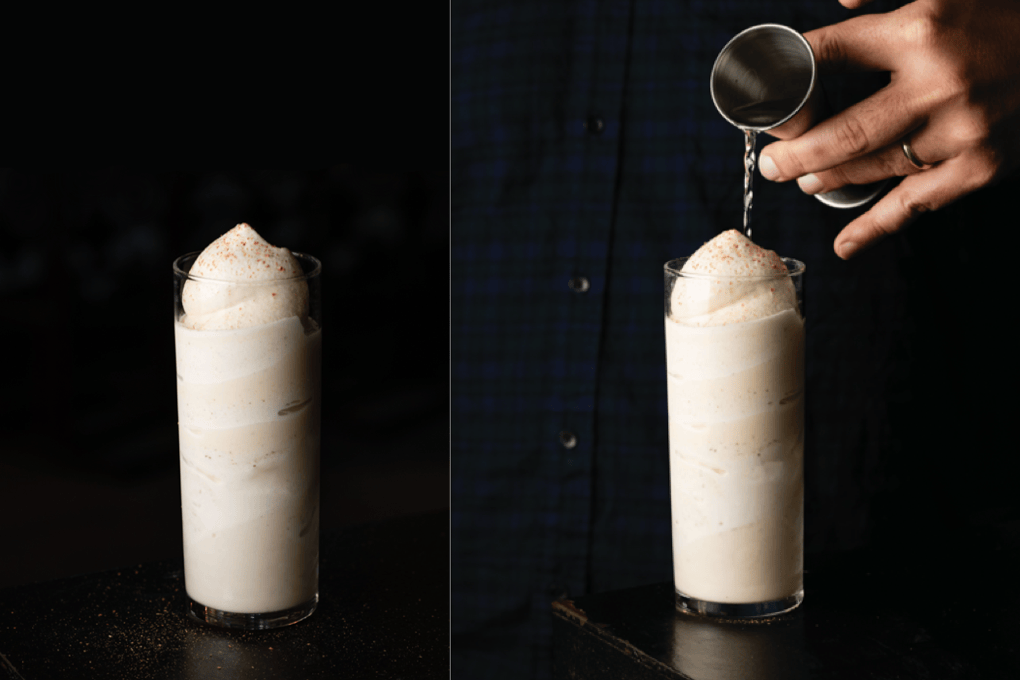 Photo Credit: Mandie Geller
Photo Credit: Mandie Geller Horchata iterations abound. San Diego’s Puesto adds a shot of rum or tequila to its Frozen Horchata for a transformative turn as the spiked “Loca” version..
The Dea Divina, served at Michael’s on Naples in Long Beach, Calif., spotlights sotol, a spirit made from the sap of the desert spoon plant, along with hoja santa, a Mexican herb known for its peppery and minty qualities. Equal Measure, a cocktail bar in Boston, offers the Next to Normal, a drink that is herbaceous yet juicy, refreshing and complex, also featuring Sotol La Higuera, plus green Chartreuse, Dolin Bianco and honeydew. “We really enjoy sotol’s grassy, vegetal notes that are hard to pinpoint,” says Nemo Bolin, executive chef. “We wanted to make it approachable, so we incorporated it into a drink that appeals to a broad audience.” Pretty Decent, a modern bar in Louisville, Ky., showcases sotol in its complex Tiger Tonic, combining the spirit with mezcal, orange and lime juices, jalapeño, ginger, turmeric and pepper.
“It was only a matter of time before mixologists tapped into the impressive library of relatively unknown regional Mexican flavors for beverage development,” says Daniel Carpenter, managing director and partner, Sterling-Rice Group. “The rise of chamoy as a key element in beverages (beyond the mangonada) and ‘michelada culture’ are just two examples of this.” Riffs on the michelada are emerging across the U.S. In Houston, Jūn injects an umami twist to the Mexican beer-based drink, combining Modelo with fish sauce, hoisin, chile and lime. Meanwhile, inspired by the jaw-dropping success of the mangonada, beverage developers are calling on chamoy, the fermented sweet, salty and spicy fruit-based condiment, to intrigue and excite diners. The Fourth Wall Break, a specialty margarita on the menu at The Blind Pig Kitchen + Bar, with two locations in California, stars housemade chamoy, ancho liqueur, tequila, apricot and chipotle bitters.
While the injection of heat is not particularly new in beverage development, innovation using Mexican-inspired flavor combinations is breathing new life into this trend. International Smoke, with locations in Las Vegas and San Francisco, serves the Piña Guey with Tres Agaves reposado tequila, Alma Tepec chile pasilla, piloncillo, lemon and pineapple tepache. Movida Lounge, a Persian-Mexican fusion restaurant in San Francisco, heats things up with its Chilosa, starring green chile-infused gin, cilantro, lime, coconut and gol gav zaban, a Persian flower tea.
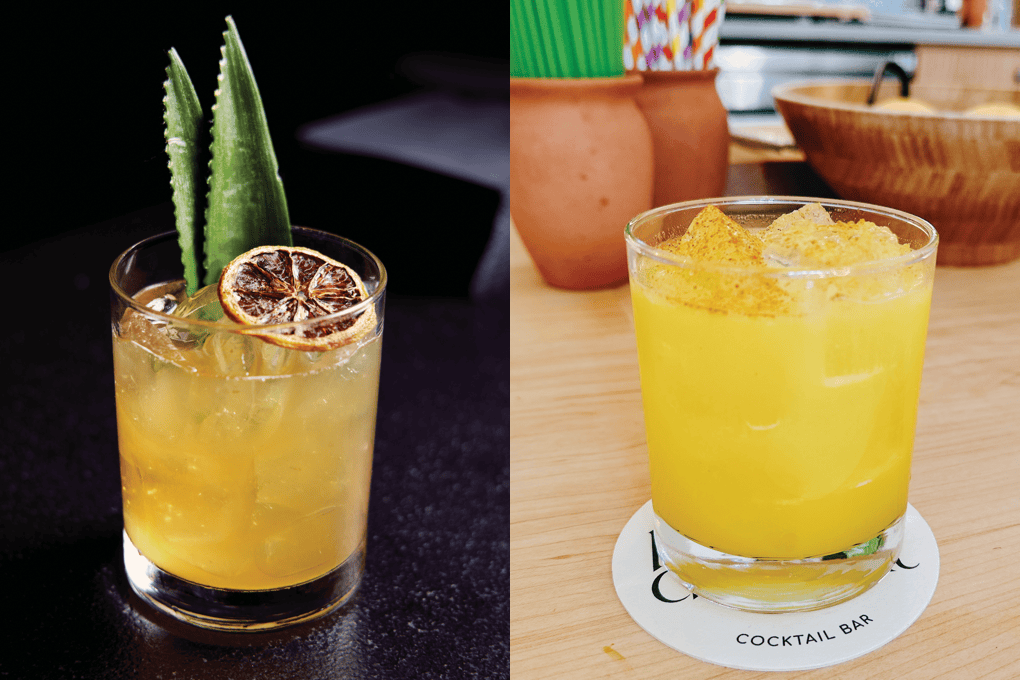 Photo Credit: Audrey Kuhn
Photo Credit: Audrey Kuhn The Piña Guey cocktail at International Smoke (left) features tequila, chile pasilla, piloncillo, lemon and pineapple tepache. Pretty Decent in Louisville, Ky., menus the Tiger Tonic (right): sotol, mezcal, orange and lime juices, jalapeño, ginger, turmeric and pepper.
Non-Alc Opportunity
Beverage developers are also finding non-alc inspirations from south of the border. The agua fresca has become well established in the U.S. thanks to its bright colors, health halo and roster of alluring, refreshing flavors, including watermelon, strawberry, hibiscus, pineapple and mango. Trend-forward combinations are the order of the day, from pineapple and cucumber to watermelon, chipotle and mint.
Horchata, Mexico’s traditional rice-and-cinnamon drink, offers a huge runway for innovation. “There’s such growth opportunity for horchata when you consider the popularity of cinnamon and alternative ‘milks,’” says Kostyo. Puesto, based in San Diego, showcases the opportunity here: The Frozen Horchata, made with organic cream, is rich, thick and frosty. Its “Loca” version gets a boozy hit of either rum or tequila. Irvine, Calif.-based chain Juice It Up! demonstrates how horchata mines success when taking on traditional flavors. Its Horchata Smoothie features a blend of almond “milk,” nonfat yogurt, dates, banana, cinnamon and chia seeds.
“We’ve just started to scratch the surface of possibility,” says Baez. “There’s so much more to explore in Mexican cuisine and culture than just what we’ve seen over the past 20 years.”
If ever there was a safe bet in modern beverage development, Mexican-inspired builds is it. American consumers provide a ready fan base, generating a fever pitch for classics like the margarita and agua fresca; rallying behind newer discoveries like mangonada, horchata and the michelada; and cheering on the adaptation of lesser-known drinks and ingredients like ponche, carajillo, sotol, palo santo and hoja santa. Today’s trend digs into all of the above, along with many more flavors direct from Mexico. To underscore the opportunity, look to the purchasing patterns of today’s consumer: The margarita is the most ordered cocktail in the U.S., and Modelo Especial now ranks as this country’s best-selling beer, according to Nielsen tracking.
“If you’re looking for a new winning beverage option, your first go-to in ideation should be around Mexican flavors. There’s overwhelming evidence that these flavors are hugely popular,” says Mike Kostyo, VP of Menu Matters consultancy. “So, now the question is: ‘How do you move it to the next level?’” Savvy developers are taking a few different approaches to next-level Mexican-inspired beverage building. They’re refreshing classic drink lineups with impactful flavor touches from the Mexican pantry, pulling in lesser-known liqueurs, fruit infusions, chile pepper accents, exotic plant syrups and garnishes, and even a few savory surprises. They’re also introducing customers to entirely new flavor combinations while giving spin to boozy and non-alc favorites with deep-rooted popularity in Mexico, from carajillo and café de olla to champurrado (a chocolate grain-based drink) and licuado (smoothie).
“There’s so much more to offer within Mexican cuisine,” says John Baez, executive chef, Border Grill in Las Vegas. “We’ve been able to dig deeper into the heart of Mexico—Oaxaca, Ensenada, Veracruz and beyond—and find all these culinary traditions and delights. That’s what’s exciting—that we’re able to be a part of this movement.”

At Michael’s on Naples in Long Beach, Calif., torched palo santo lends the mezcal-forward Dea Divina cocktail both drama and aromatic depth.
Building on Favorites
The most straightforward play sees beverage developers applying Mexican influences to cocktail classics. It’s a sound strategy. “If you already have a beverage that’s doing well on the menu, add an iteration that features Mexican flavors and ingredients,” says Kostyo. At Ghost Commerce in Commerce Charter Township, Mich., an Old Fashioned morphs into the Añejo Old Fashioned, featuring El Mayor Añejo, orange bitters and agave. Across the country, at Paradisaea in La Jolla, Calif., the Oaxacan Negroni surprises with Tamarindo Mezcal, rosé vermouth, ancestral Mexican corn liqueur and Artigianale bitters. Sal de gusano (worm salt) is sprinkled over top to finish the drink.
Riding the popularity of the espresso martini, and demonstrating the appeal of Mexico’s own classics, the carajillo is making moves on American menus, with beverage developers offering riffs on the traditional combination of strong coffee and Licor 43, a Spanish liqueur with notes of warm spices, citrus and vanilla. At Suerte in Austin, Texas, the Carajito is carajillo-inspired, with rum, Licor 43, Fernet-Branca, cold brew and spiced cocoa bitters.
Indeed, the carajillo is an example of an easy layup for American beverage development, says Baez. “It’s the next evolution of the espresso martini and will gain a following because it’s in the comfort zone of Mexican flavors. Ponche has similar potential,” he says. Mexican ponche is a style of warm punch, typically made with apple, pear, orange and guava, then spiced with cinnamon, cloves, tamarind and hibiscus. Variations abound, including chilled and boozy versions. At Washington, D.C.’s dLeña Roja, the Piña Punch is made with coconut fat-washed mezcal, ginger-mint syrup, lime and pineapple soda. Simone’s Bar in Chicago menus Ponche de Pilsen, an iced punch with mezcal, Bitter Truth dram and housemade Christmas punch flavored with fruit, hibiscus and spices.
 Photo Credit: Kikkoman Sales USA
Photo Credit: Kikkoman Sales USA The Michelada at Jūn in Houston is an umami-rich spin on this classic, featuring Modelo, fish sauce, hoisin, chile and lime, with an eye-catching cauliflower garnish.
On the Horizon
Mexico’s culinary landscape, rich with diverse flavors, provides fertile ground for imaginative menu development. “There’s so much out there that we can leverage to make popular, great-tasting drinks,” says Baez. “We think about mole rims and infusions of tepache or agua fresca as mixers, and we like to highlight Mexican versions of traditional spirits, like sotol and Mexican corn whiskey.” Kostyo agrees: “We’ve seen mezcal grow on menus over the last five years. But if you want to be ahead of the curve, look to those next-generation, interesting, distilled spirits coming out of Mexico, like sotol.”
 Photo Credit: Mandie Geller
Photo Credit: Mandie Geller Horchata iterations abound. San Diego’s Puesto adds a shot of rum or tequila to its Frozen Horchata for a transformative turn as the spiked “Loca” version..
The Dea Divina, served at Michael’s on Naples in Long Beach, Calif., spotlights sotol, a spirit made from the sap of the desert spoon plant, along with hoja santa, a Mexican herb known for its peppery and minty qualities. Equal Measure, a cocktail bar in Boston, offers the Next to Normal, a drink that is herbaceous yet juicy, refreshing and complex, also featuring Sotol La Higuera, plus green Chartreuse, Dolin Bianco and honeydew. “We really enjoy sotol’s grassy, vegetal notes that are hard to pinpoint,” says Nemo Bolin, executive chef. “We wanted to make it approachable, so we incorporated it into a drink that appeals to a broad audience.” Pretty Decent, a modern bar in Louisville, Ky., showcases sotol in its complex Tiger Tonic, combining the spirit with mezcal, orange and lime juices, jalapeño, ginger, turmeric and pepper.
“It was only a matter of time before mixologists tapped into the impressive library of relatively unknown regional Mexican flavors for beverage development,” says Daniel Carpenter, managing director and partner, Sterling-Rice Group. “The rise of chamoy as a key element in beverages (beyond the mangonada) and ‘michelada culture’ are just two examples of this.” Riffs on the michelada are emerging across the U.S. In Houston, Jūn injects an umami twist to the Mexican beer-based drink, combining Modelo with fish sauce, hoisin, chile and lime. Meanwhile, inspired by the jaw-dropping success of the mangonada, beverage developers are calling on chamoy, the fermented sweet, salty and spicy fruit-based condiment, to intrigue and excite diners. The Fourth Wall Break, a specialty margarita on the menu at The Blind Pig Kitchen + Bar, with two locations in California, stars housemade chamoy, ancho liqueur, tequila, apricot and chipotle bitters.
While the injection of heat is not particularly new in beverage development, innovation using Mexican-inspired flavor combinations is breathing new life into this trend. International Smoke, with locations in Las Vegas and San Francisco, serves the Piña Guey with Tres Agaves reposado tequila, Alma Tepec chile pasilla, piloncillo, lemon and pineapple tepache. Movida Lounge, a Persian-Mexican fusion restaurant in San Francisco, heats things up with its Chilosa, starring green chile-infused gin, cilantro, lime, coconut and gol gav zaban, a Persian flower tea.
 Photo Credit: Audrey Kuhn
Photo Credit: Audrey Kuhn The Piña Guey cocktail at International Smoke (left) features tequila, chile pasilla, piloncillo, lemon and pineapple tepache. Pretty Decent in Louisville, Ky., menus the Tiger Tonic (right): sotol, mezcal, orange and lime juices, jalapeño, ginger, turmeric and pepper.
Non-Alc Opportunity
Beverage developers are also finding non-alc inspirations from south of the border. The agua fresca has become well established in the U.S. thanks to its bright colors, health halo and roster of alluring, refreshing flavors, including watermelon, strawberry, hibiscus, pineapple and mango. Trend-forward combinations are the order of the day, from pineapple and cucumber to watermelon, chipotle and mint.
Horchata, Mexico’s traditional rice-and-cinnamon drink, offers a huge runway for innovation. “There’s such growth opportunity for horchata when you consider the popularity of cinnamon and alternative ‘milks,’” says Kostyo. Puesto, based in San Diego, showcases the opportunity here: The Frozen Horchata, made with organic cream, is rich, thick and frosty. Its “Loca” version gets a boozy hit of either rum or tequila. Irvine, Calif.-based chain Juice It Up! demonstrates how horchata mines success when taking on traditional flavors. Its Horchata Smoothie features a blend of almond “milk,” nonfat yogurt, dates, banana, cinnamon and chia seeds.
“We’ve just started to scratch the surface of possibility,” says Baez. “There’s so much more to explore in Mexican cuisine and culture than just what we’ve seen over the past 20 years.”
About the Author
Katie Ayoub serves as managing editor of Flavor & The Menu and content strategist for the Flavor Experience, an annual conference geared toward chain operators. She is president of Katie Ayoub & Associates, serving up menu trends expertise, content creation and food & beverage consultancy. Based in Chicago, Katie has been working in foodservice publishing for more than 20 years and part of the Flavor team since 2006. [email protected]

